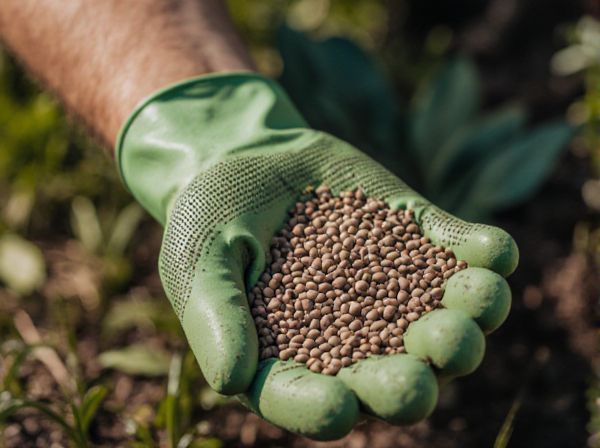
Dry seeds vs Soaked seeds Illustration
Dry seeds require more time to absorb moisture and activate their metabolic processes for germination, often resulting in slower sprouting. Soaked seeds absorb water beforehand, which accelerates the breakdown of seed coats and enhances enzyme activity, leading to faster and more uniform germination. Pre-soaking seeds also improves overall seedling vigor by reducing dormancy and increasing the likelihood of successful seedling establishment.
Table of Comparison
| Aspect | Dry Seeds | Soaked Seeds |
|---|---|---|
| Germination Speed | Slower, may take days to weeks | Faster, typically 1-3 days |
| Water Absorption | Minimal until planted | Pre-absorbed, ready for growth |
| Viability | Stable if stored properly | Higher initial risk of mold if soaked too long |
| Preparation Time | Minimal, direct sowing possible | Requires soaking 8-24 hours before planting |
| Energy Use for Germination | Seeds expend more energy to absorb water | Seeds conserve energy; hydration stage bypassed |
| Best Use | Long-term storage, easy transport | Quick germination, improving uniformity |
Understanding Seed Germination: Basics and Importance
Dry seeds require adequate moisture and temperature to initiate germination, relying on internal reserves to support early growth stages. Soaked seeds absorb water prior to planting, accelerating enzymatic activity and cellular metabolism, resulting in faster and more uniform germination rates. Understanding these differences enhances seed treatment strategies to optimize germination success and improve crop establishment.
Dry Seeds: Advantages and Common Uses
Dry seeds offer superior storage longevity due to their low moisture content, reducing the risk of fungal infections and premature germination. This characteristic makes them ideal for long-term seed banking and agricultural seed distribution. Farmers commonly prefer dry seeds for field sowing because they maintain viability and are easier to handle and store.
Soaked Seeds: Benefits and Techniques
Soaked seeds accelerate germination by softening the seed coat, which enhances water absorption and activates metabolic processes more quickly. Techniques such as soaking seeds in room temperature water for 12 to 24 hours improve germination rates and reduce seed dormancy. This method is particularly effective for hard-coated seeds like beans, peas, and sunflower, promoting uniform and faster sprouting.
Comparing Germination Rates: Dry vs Soaked Seeds
Soaked seeds typically exhibit higher germination rates compared to dry seeds due to enhanced water absorption, which activates metabolic processes essential for sprouting. Dry seeds require longer imbibition periods, delaying enzymatic activity and cell expansion, resulting in slower germination. Studies show that soaking seeds for 12 to 24 hours can increase germination rates by 20-40%, particularly in hard-coated varieties like beans and peas.
Factors Affecting Seed Germination Success
Dry seeds often require longer imbibition periods to initiate germination, while soaked seeds absorb water faster, accelerating the activation of metabolic processes. Factors affecting seed germination success include water availability, temperature, oxygen supply, seed coat permeability, and seed viability, all of which influence enzymatic activity and embryo development. Pre-soaking seeds can enhance germination rates by overcoming initial dormancy and facilitating uniform moisture distribution essential for successful seedling emergence.
Best Plant Types for Dry Seed Sowing
Dry seed sowing is best suited for hardy plant types such as carrots, lettuce, and beans, which can germinate effectively without pre-soaking. These seeds benefit from direct soil contact, allowing natural moisture to trigger germination at the optimal time. Dry seed sowing reduces the risk of seed rot and is ideal for crops adapted to variable moisture conditions.
Plants that Benefit Most from Pre-Soaking
Plants such as beans, peas, and lentils benefit most from pre-soaking seeds, as it accelerates germination by softening their hard seed coats. Dry seeds of woody plants or legumes with tough seed coats demonstrate improved water absorption and faster sprout emergence after soaking. Pre-soaking seeds in water typically for 12-24 hours enhances enzymatic activity, promoting cell expansion and improving overall seedling vigor.
Potential Risks and Challenges: Dry vs Soaked Seeds
Dry seeds face challenges such as slower germination rates and lower initial water uptake, which can delay seedling emergence and reduce overall vigor. Soaked seeds are at risk of oxygen deprivation and fungal infections due to excessive moisture, potentially leading to seed rot and loss of viability. Managing moisture levels and exposure time during soaking is critical to minimize these risks and optimize germination success.
Practical Tips for Soaking Seeds Before Planting
Soaking seeds before planting significantly improves germination rates by softening the seed coat and accelerating water absorption. Practical tips include using warm water and soaking seeds for 6 to 12 hours, avoiding overly long soaking that can cause seed rot. After soaking, drain the seeds thoroughly and plant them immediately in moist, well-drained soil to maximize sprouting success.
Which Germination Method is Right for Your Garden?
Dry seeds germinate more slowly as they require moisture absorption before cellular activity begins, making them ideal for controlled environments or staggered planting schedules. Soaked seeds, having pre-absorbed water, can germinate faster and more uniformly, boosting initial growth in gardens needing quick establishment or in climates with shorter growing seasons. Choosing the right method depends on plant species, soil conditions, and desired germination speed, balancing moisture availability with seed type for optimal sprouting success.
Dry seeds vs Soaked seeds Infographic

 gardendif.com
gardendif.com